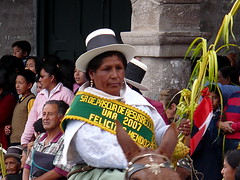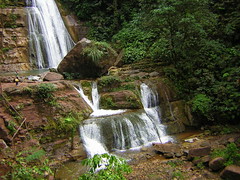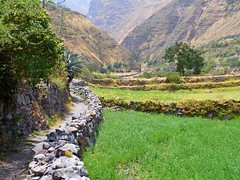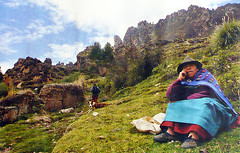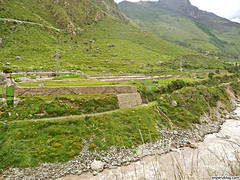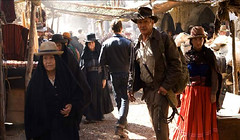Huayco (also Huaico) is a Peruvian term for the flash floods that occur regularly during the rainy season in the Andes. Often they are regular but minor, such as the one that affected me yesterday in the Chillón valley, blocking the road with mud, boulders and a torrent of water for several hours. Other times they can be more violent, washing away bridges and even towns.
Category: "Lima City Guide"
Morro Solar
The Morro Solar of Chorrillos was the scene of a battle, was once an exclusive beach resort in the 1800s and nowadays is home to an observatory, some monuments and the exclusive Regatta’s club.
Lima’s other side
The fertile green mountain valleys of the Andes were traded for the rocky desert wasteland that is the Peruvian desert coast. There were no homes for the new arrivals, nor land, nor money to buy either – so they had to invade.
Larcomar
A sunny day in Miraflores, as new penthouses tower over the up-scale Larcomar shopping mall, which sits embedded in the cliffs of the Coast Verde overlooking the Pacific Ocean.
Lima, Peru, 1944
Before Lima’s explosive growth it was a small, quiet, clean and very modern city. This documentary video, funded by the United States Office of the Coordinator of Inter-American Affairs in 1944 shows us a time that many older Limeños hold in high regard and with great nostalgia.
Walking in Lima
Walking is my favorite form of transportation in Lima and I do it just about every day without fail. The biggest downfall of walking is that, well, if you walk in Lima, you will eventually have to cross the street. And cars drive in the street. I’ve heard that in Lima, six people are run over and killed every day. Not just run over. Run over and killed. And, after living here for four months, it seems like an Act of God that the number is so low.
Caral – The “Oldest” Civilisation in the Americas
In ancient times, as the peoples of the Nile valley in Egypt and the peoples of the Indus valley in India came together to form cooperative societies, so too did the people of the Supe valley in Peru. In groups of family units of small scale farmers and fishers they began to form systems of government, religion and trade.
Chosica
The building of the central andean railway heralded the birth of the town of Chosica – Lima’s residents favourite place to avoid winter days and breathe some fresh air.
Emilio Agustín del Solar y Mendiburu was a public prosecutor for the Supreme Court, a council member for the Province of Lima and a top lawyer for the company that ran the new railway. It was when he was inflicted with a debilitating illness that he decided to leave Lima’s damp humid environment and move to an area along the Rimac river known as Chosica Vieja.
Poor people, Historic buildings
I still haven’t gotten used to the fact that in Peru the poor are the ones who live in the oldest, most historic and most culturally valuable buildings in the country, and in some cases most of South America.
It’s still strange to me that some of the most run-down, rough and poorest neighbourhoods are also the oldest, and that they are falling apart and no-one seems to care.
What’s strange to Peruvians, especially those who live in these buildings that can be hundreds of years old, is that in most other countries these buildings would be snapped up by the richest of the rich and be worth millions if not tens of million of dollars.
Pileta del Pisco
Peru’s national drink flowed from Lima’s 357 year old fountain in the Plaza de Armas today in honour of the country’s 186th anniversary of independence tomorrow. Where water flowed yesterday, pure Pisco spirit flowed today. To learn about Pisco, how it’s made and when and where it was invented, see here.
Ruins of the Lurín Valley
There have been so many ancient cultures in Peru who have gone on to create so many citadels, farming terraces, temples and pyramids that you often only need to climb the nearest hill to find remnants of their existence. Because of this the vast majority of the country’s archaeological sites are relatively unknown, unvisited and unprotected.
Tio Mario
It has been 20 years since a cart selling anticuchos appeared on the streets of the district of Barranco. Every afternoon Mario Farfán and his wife would sell their anticuchos to passers-by eventually saving enough money to open what is today one of the best anticucherías in Barranco. Mario’s cart has been exchanged for a large restaurant in a prime location overlooking the Bridge of the Sighs which he was able to buy for $160,000 US.



